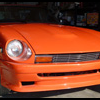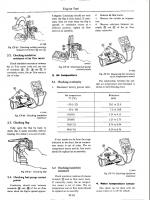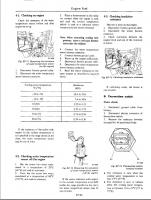Everything posted by darom
-
TPS/smog and high CO discussion
Greetings, Before I bore you guys with a lengthy post, here is the question: can a misadjusted TPS (in an always lean condition) cause high COs? My numbers were at 15 mph - 5.01 (allowed 1.36), and at 25 mph - 5.42. HC - 113 (max 214) at 15 mph and 86 (max 181) at 25 mph. The car is 1976 280z, stock + catalytic converter. My TPS and lousy weak spring linkage wouldn't return the idle back to the far right/middle TPS metal contacts and would stay in the middle position (lean/cruise mode). The dashpot also would be very slow to return the idle. I searched and found a bunch of threads where TPS was one of the reasons why our cars might run rich. My dilemma is that in their cases the TPS was in the WOT position, which commands ECU to dump more fuel, thus creating the rich condition. In my case it seems that the TPS was always in the middle/lean position. Would this attribute to my smog problem with high COs? Logically, it should be running lean. Am I wrong? Here is what has been done: - FI Bible and fuel injector FSM - all troubleshooting steps returned positive results (thermotime switch, water temp sensor, operation of the CSV, AFM resistance, AFM temp sensor readings, injector operation). The sensor readings were taken with cold/hot engine. - all vacuum hoses and PCV valve are new - AFM rubber boot is new - new intake gasket - fresh oil change, oil filter, air filter, new NGK spark plugs (gapped at 0.039) - fuel tank was cleaned, fresh gas and fuel filter. The car idles at 800, ign. timing is at 10, vacuum is at 17, fuel pressure (not running test - 36 psi), running it stays at 30 psi. The CSV is not leaking. The spark plugs look dark, cylinder 5 - shows some oil/fuel (hard to tell). I haven't played with AFM yet. This is going to be my last stop (hopefully). Air regulator is faulty (it doesn't close) and i just pinched the hose. It will be replaced. The car starts with a half-turn of the ignition key. It runs great. It passed smog 2 years ago. What I haven't done: - pull the fuel rail with injectors and check for leakage (especially, cylinder number 5) - attach voltmeter to the CSV while the car is running and check for voltage presence (to isolate CSV dripping during the normal operation). I have also adjusted the TPS to have proper contact engagement at idle. The contacts break loose as soon as the throttle is applied (how important is 1400 rpms?). It was really hard to aim for 1400 rpms limit to disengage the contacts. The WOT is applied almost at the end of the throttle pedal application. I installed 2 springs to the throttle linkage. It closes and returns to idle fast. The dashpot was adjusted to catch the throttle movement at the end. My mechanic's smog equipment is getting repaired. I will take my car next week to do a simple tail pipe sniffer test to see how rich the mixture will get. Before I see him, I'd like to cover all my bases. We probably can tinker with the AFM at his shop. Thanks in advance for your input. Den
-
okay, lets try this
You can tell the difference by looking at the seat rails: 240 seats have straight mounting rails. 280z - the rail ends are angled. The rails are easy to remove and interchange between the 240 and 280 seats. I am not sure about 260 seats. Maybe someone else can add? I have 76 seats that were trashed. 240 seats fit like a glove with the rails replacement. The shape wise the seats look identical. The only difference I noticed was the reclining handle. The 280z reclining mechanism plastic cover didn't fit the 240.
-
gas/brake pedals predicament
Blue, excellent idea - I can fab a nice looking aluminum piece and screw it down to the tranny tunnel hump to push the carpet away. Thanks!
-
gas/brake pedals predicament
Agreed, the only problem is my carpet is tucked under the central console (which was a royal pain in the neck to install). The console retaining bracket holds each side of the carpet :-(
-
gas/brake pedals predicament
Sorry, I should have mentioned it in the post: the car has a standard 5-speed.
-
gas/brake pedals predicament
Hi guys, I think I overdid with my sound deadening material, jute padding and a carpet in the gas pedal area. My 10 size shoe rubs against the brake pedal. The interior has been redone, the carpet/jute padding were glued there since the molded carpet was 'sticking out' too much causing interference with the gas pedal getting stuck on its own. I was afraid I was going to repeat the stuck Toyota's gas pedal syndrome :-). I found a thread which deals with replacing the pedals with aftermarket parts: http://www.classiczcars.com/forums/showthread.php?15438-Pedal-Upgrade&highlight=gas+pedal+move I am considering a few options: 1. With a BFH and 2x4, hammer down the tunnel metal. 2. Buy the replacement pedal covers hoping their size will be smaller than stock (wishful thinking?) 3. Relocate the brake pedal to the left, if possible? The brake pedal's rod is quite thick, it will be probably hard to bend it. In your opinion, which one is better or if you have your ideas I'd appreciate it. Thanks in advance.
-
No 4 way flasher switched installed...
EverRude, before you installed the hazard switch, take it apart (4 small screws) and clean the contacts inside with a fine grit sand paper. It will take you a few minutes.
-
Ceramic coat stock manifold?
Eric, If you could find out and post here how much your best friend is going to charge us for ceramically coating the stock exhaust manifolds, I'd appreciate it. There must be a reason why Nissan put that heat shield there :-) Thanks!
-
new battery cables ?
I used one of the Jegs' battery terminal covers on my positive post: http://www.jegs.com/i/Taylor/895/20670/10002/-1 or this: http://www.amazon.com/Ancor-260392-Electrical-Terminal-Rotationg/dp/B000NI1FVC
-
Audio Systems
Chris, Good job. Your whole setup is begging now for a carpet or vinyl cover or better yet, a fiber glassed top! :-)
-
Speakers for 280z
Pops, do you have just rear speakers, and nothing in the front? I am debating between having just 6x9 in the rear, or fabbing 5 1/4" speaker enclosures and installing them in the kick panels (little room there unfortunately). Thanks.
-
Pay it forward!!!
Prefer local pick-up in Bakersfield, CA. From 76 280z: - removed used a/c parts (compressor, seized pulley, vacuum canister, brackets, some relays and vac. tubing). The box is heavy and needs to go as one unit, please. A/c was disconnected in the car when I bought it, the a/c compressor's condition is unknown. A heater core will be included. Chevy 350 engine bare block, 4-main, I acid dipped it a few years ago, still has surface rust. 0-over if I am not mistaken. It will definitely need to be bored out. For faster response please email me at simzealot at gmail doooootttttt com. Den
-
76 no start problem
Hopefully, final update: - the replacement ECU got my car running again without any hot wiring gimmicks to the CSV. Thanks to all who helped me through this ordeal!
-
76 no start problem
Adrian, 1. I mistyped - sorry, it was measured 2.68 kOhm 2. Re: options pin 1 kick-back - I will have to take the ECU's cover off to get my multimeter to the pin number 1 to get that voltage. I believe it does go to 400-600V range. 3. Output stage transistor on the side - easy to replace since the solder points are big with plenty of space on the circuit board. There are actually two of them. 4. I will trace pin 1 lead and see where it connects to on the board. I can borrow an oscilloscope from a friend of mine. I am not sure if my voltmeter has hFe setting. I will double check it. I'd love to fix my bad ECU even if I bought/have another unit. I don't mind working with electrical problems because there is logic to them (broken inside distributors or leaking oil pan is a different story). We can keep the resoldering ECU business off this board via private emails to keep other threads on top. If classiczcars members are interested, I can attach the PDFs/images of troubleshooting later to this thread to sum it all up. Thank you!
-
76 no start problem
A few more tests done: 1. I made each injector click when the corresponding pins were grounded (15, 33, 32, 14, 30, 31) and the ignition switch in ON position. 2. There is battery voltage at the coil, and spark at the leading coil wire to the distributor (when held close to ground while cranking the engine) 3. AFM passed all the tests, 9 and 8 pin - 103 Ohm 6 & 8 - 180 Ohm 27 & 6 air temp sensor - 26.8 kOhm Potentiometer is good with flap door being gradually opened. The voltage went down in incremental steps on pins 8 and 7 (EF-51) 4. Water temp sensor shows 2700-2800 Ohm I also hooked up the fuel pressure gauge - 37 psi at START. I appreciate any advice on making the ECU ground the injectors now :-) Thanks!
-
76 no start problem
Adrian, I think my thermotime switch is faulty - I will need to run some tests on it per the FSM. I grounded the thermotime pin while cranking the engine. The amount of fuel it sprays should be enough. I was actually afraid to flood it. Nothing has changed, I was testing the wrong leads back to the cabin for 12V (user error). There is voltage at the coil and there is continuity between the coil (-) and the ECU's pin 1. I will run some tests on AFM per the Fuel Inj. book. Can a bad TPS cause the engine _not_ to start? I removed the intake while changing the studs/gasket - maybe the TPS sensor finally decided to quit? I will re-check its connector settings as well. Thanks for your help!!!
-
76 no start problem
Another update: - Ignition switch's START wire to 86a/76 (ign. relay) -> continuity - Ign. relay 4/47/86 to ECU's 4 pin -> continuity - CSV pin 47 to the ign. relay 4/47/86 pin -> continuity - CSV pin 47 shows 12V when the key is in START (it is alive!) - When the thermotime switch's 46 pin is grounded -> CSV squirts fuel (I took it out) Installed the CSV back into the intake, the engine just cranks. I can't hear the injectors clicking at all. Fuel pump runs. I am guessing the ECU doesn't pulse the injectors on pins 33, 32, 31, 30, 15 and 14. I wish I had a circuit board diagram to see which part of the ECU is managing the injectors. My replacement ECU is going to be here in a few days. Thanks!
-
76 no start problem
Excellent, thanks - I will trace the wire (my 2 fuel inj. relays are out, should be a pretty straight forward operation).
-
76 no start problem
Update: no voltage is registered on the CSV connector, neither in the case when 46 is grounded, no voltage shows up on the other CSV plug. The ECU is definitely fried.
-
76 no start problem
Adrian, I will run those 2 tests (voltage at CSV and pin 46 ground) tonight after work. Thanks!
-
76 no start problem
The lead path from pin 4 goes to the T300 transistor (C1833 L281) on the 'daughter' card circuit. Does anybody have a circuit board diagram for a 1976 ECU? Thanks!
-
76 no start problem
Adrian, you are _good_! I ran the test on page 69 (CSV disconnected) and it registers my battery voltage on pin 4. So I think the wiring is good through the ign. relay all way down to the ECU. I think the ECU fails to provide ground on pin 21 for the CSV (page 71). Hmm, I just rechecked - my ECU doesn't have any leads on pins 20, 21. Now I am guessing the Nissan engineers ran the wire (21) from CSV to the ECU harness plug just for testing sakes. The CSV gets its ground from the thermotime switch, positive off the fuel ign. relay (47). On my circuit board the following pins are soldered: 1-18, 30-35, 26-27. You can be right, that pin 4 might be the culprit in my ECU. I checked the resistor on pin 4 and it looks ok (24k ohm). Red-yellow-orange-gold 24k Ohm +/- 5%. Beyond that I am not much help testing the board :-( For pictures, please find them here: http://s24.photobucket.com/albums/c1/darom/280z/ Thanks. I appreciate your guys help!
-
76 no start problem
Adrian, thanks for a good explanation. I am basically at the same conclusion as you are in regards to the PO's wiring. The CSV never got the ECU's 12V to engage, thus the butchered wiring solution (The CSV on 280-z works only when the engine is being cranked. That's why the PO's wiring was off the START ignition wire to the CSV directly bypassing the ECU pins.). When I bought the car, the PO re-assured me that he had replaced the ECU with a rebuild unit. That's why I have been delaying its replacement (esp. when the car's engine ran) until I discovered the relay/CSV hook-up etc. The cold start system circuit passed the test (page 71 of the Elect. Fuel Injection 280-z book" with the harness disconnected from the ECU, starter solenoid lead wire disconnected, ign. key in START position. Here is the reference: http://www.atlanticz.ca/zclub/techtips/efisystem/280zfuelinjectionbook.pdf I found a used 76 ECU - I will update the thread once it is installed. Maybe someone will benefit from this in the future. Adrian, I like your avatar signature: "Registered Ign/ECU Nurse: :-)
-
76 no start problem
Update: did a manual (touch 3 times the ignition lead wire) ECU injector test per the Injection Book and it failed. It appears the ECU fails to start the injectors. The wiring harness passed all the tests (continuity to injectors, to coil (-) and to grounds). I took apart the ECU, all soldered connectors were in a good shape, tested each lead. I guess I will start looking for a ECU replacement (the one I have is from a different year). What still puzzles me how the heck the car ran before I removed that CSV hot wire/relay and redid the manifold/intake gasket?
-
76 no start problem
I had too much coffee -- the ECU controls the injector pulses. I completely confused the transistor unit (spark control) with the ECU (injector pulses). There is continuity on pin 1, ballast resistor's (-)/tach lead. I am going to take apart the ECU and see if pin 1 inside is not loose (I will re-solder it). Someone on zcars.com forums had some issues with old solder points creating bad connections.








